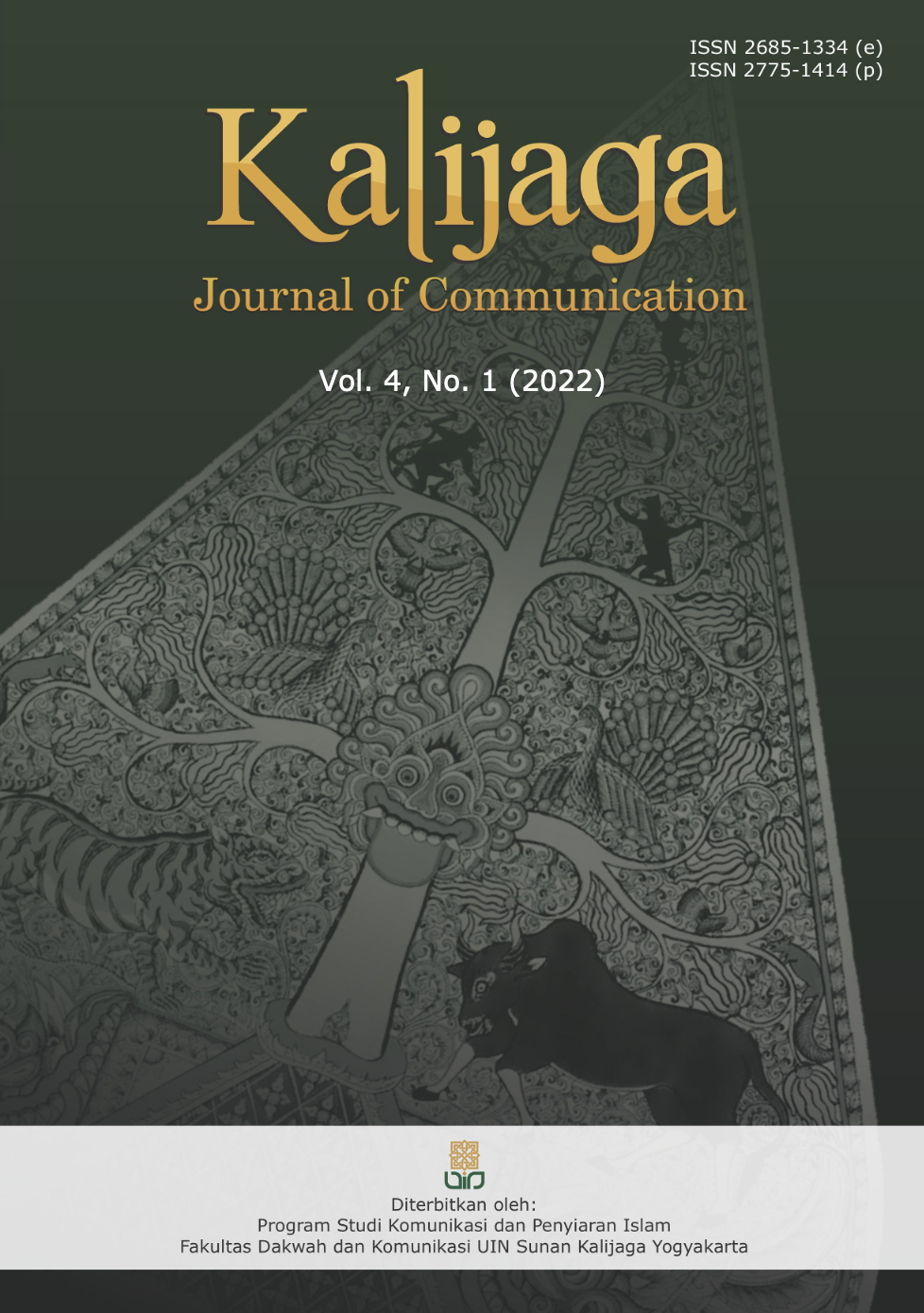Representasi Feminisme di Iklan Minuaman Olatte Versi “Taste Of Friendship Ep 1 (Cara Ranty Ungkapin Hati)”
DOI:
https://doi.org/10.14421/kjc.41.05.2022Keywords:
Advertisement, Feminism, Iklan, John Fiske, Olatte, RepresentasiAbstract
ABSTRACT
The rapid development of advertising in recent years, since there are many factors, such as: development of modernisation, culture and also internet. Nowadays, advertisement not only find in the television, but you also easily find the advertisement in social media. Youtube is the most used social media, since they have number 1 rank in Indonesia as the favourite of social media, the percentage of the score is 93,8%. This research used semiotics theory by John Fiske to analysis the data. The result of this research finds 3 level from the Olatte’s advertisement, such as: Level of reality, in this level find the4 codes (dress, speech, gesture, makeup and expressions). The second one is level of representation, in this level the researcher find 3 codes (Teknik of camera, lighting and music). The last one in the level of ideology, the researcher finds the liberal of feminism used in this advertisement, also liberal feminism is the most dominant that used in this advertisemet.
 Abstract viewed: 353 times
|
Abstract viewed: 353 times
|
 PDF downloaded = 595 times
PDF downloaded = 595 times
References
Adams, S. (2017). The Dessigner’s Dictionary of Color. New York: Quid Publishing Ltd.
Ardianda, A., & Sudrajat, R. (2016). Representasi Kecantikan dalam Video Klip Bercahaya (Analisis Semiotika John Fiske Dalam Iklan Kosmetik PONDS). e-Proceeding of Management, 2549.
Bella , E., & Kurnia, D. (2015). You Look Disgusting: Kritik Atas Citra Kecantikan Telaah Semiotika John Fiske Terhadap Representasi Feminisme Modern. 9.
Diani, A., & Lestari, T. M. (2017, S September). REPRESENTASI FEMINISME DALAM FILM MALEFICENT. 139-150. Retrieved from http://jurnal. unpad.ac.id/protvf
Effendy, O. U. (2009). Ilmu Komunikasi Teori dan Praktek. Bandung: PT Remaja Rosdakaya.
Hall. (2015). Metrosexual Masculinities. UK: PalgraveMacmillan.
Kuhnke, E. (2016). Body Language Learn How To ReadOthers and Communicate
With Confidence. (F. Publish, Ed.) Capstone.
Lailatul, U. (2021). Perspektif Single Profesional Women Tentang Pernikahan di
Kota Surabaya Dalam Tinjauan Feminisme Liberal.
Mondry. (2008). Pemahaman Teori dan Praktik Jurnalistik. Bogor: Ghalia Indo- nesia.
Morissan. (2013). Teori Komunikasi: Individu Hingga Massa Edisi Pertama. Ja- karta: Kencana Prenada Group.
Mulyana, D. (2005). Nuansa-Nuansa Komunikasi Meneropong Politik dan Budaya Komunikasi Masyarakat Kontemporer. Bandung: PT Remaja Rosdakaya.
Navarro, J. (2018). The Dictionary of Body Language. In A Field Guide to Human Behavior. Harper Collins.
N, N. (2020). Zap Beauty Index 2020. Retrieved from http://zapclinic.com/ blog/lifestyle/bangkitnya-gen-z-di-industri-kecantikan-zap-beauty-in- dex-2020/221
N, N. (2021, November 10). Data Penguna Media Sosial di Indonesia Tahun 2021. Retrieved from https://www.iimers.com/data-pengguna-media-so- sial-di-indonesia-tahun-2021/
Nisa, C. A., & Nugroho, C. (2019, Agustus). Representasi Feminisme Dalam Film Drama (Analisis Semiotika John Fiske Drama Korea My ID is Gangnam Beauty). e-Proceeding of Management, 6, 5295.
Pilliang, Y. A. (2003). Hipersemiotika, Tafsir Cultural Studies Atas Matinya Makna. Yogyakarta`: Jala Sutra.
Quesenberry, K. A. (2019). Social Media Strategy, Marketing, Advertising, And The Public Relation In The Consumer Revolution. London: Rowan dan Littlefield.
Riksaning, K. (2021). Analisis Resepsi Objektifikasi Seksual Dalam Tayangan Puteri Indonesia 2020.
Sabir, T. A. (2022). Strategi Literasi Media Baru dalam Mengedukasi Masyarakat Mengenai Jejerasan Seksual ()Studi Kasus Pada Channel Youtube Remo- tivi). Makassar.
Safira, C. (2019). Pemaknaan Khalayak tehadap Resistensi Maskulinitas Boyband Korea dalam Reality Show “Wanna One Go in Jeju”.
Setyawan, I. (2021). Representasi Embodiment Melalui Konteks Local Queer Dalam Film Kucumbu Tubuh Indahmu.
Sutanto, O. (2017). Representasi Feminisme Dalam Film “Spy”. Jurnal e-komu- nikasi.
Tong, R. P. (2010). Feminist Thought. Yogyakarta: Jala Sutra.
Verra, N. (2014). Semiotika Dalam Riset Komunikasi. Bogor: Ghalia Indonesia.
Wahjuwibowo, I. S. (2018). Semiotika Komunikasi Aplikasi Praktis Bagi Penelitian. Jakarta: Mitra Wacana.
Wibowo, I. (2011). Semiotika Komunikasi. (Vol. 1). Jakarta: Mitra Wacana Media.
Widyanigsih, W., & Hermawati, T. (2020). REPRESENTASI FEMINISME LIB- ERAL DALAM IKLAN YOUTUBE (Analisis Semiotika Representasi Feminisme Liberal dalam Iklan Nivea versi #ExtraCare for Extra Wom- en di Youtube). jurnal komunikasi iklan. Retrieved from https://digilib. uns.ac.id/dokumen/detail/79747/Representasi-Feminisme-Liberal-da- lam-Iklan-Youtube-Analisis-Semiotika-Representasi-Feminisme-Liber- al-dalam-Iklan-Nivea-Versi-Extracare-For-Extra-Women-di-Youtube
Wijaya, M. P. (2013). Representasi Perempuan Pada Iklan Televisi Dancow Calcium Plus Versi More Than A Woman. Retrieved from https://www. neliti.com/publications/83874/representasi-perempuan-pada-iklan-tele-visi-dancow-calcium-plus-versi-more-than-a
Downloads
Published
Issue
Section
License
Copyright (c) 2022 Annisa widya Paramitha

This work is licensed under a Creative Commons Attribution-ShareAlike 4.0 International License.
Authors who publish with this journal agree to the following terms:
- Authors retain copyright and grant the journal right of first publication with the work simultaneously licensed under a Creative Commons Attribution-NonCommercial-ShareAlike 4.0 International License. that allows others to share and adapt the work with an acknowledgement of the work's authorship and initial publication in this journal.
- Authors are able to enter into separate, additional contractual arrangements for the non-exclusive distribution of the journal's published version of the work (e.g., post it to an institutional repository or publish it in a book), with an acknowledgement of its initial publication in this journal.
- Authors are permitted and encouraged to post their work online (e.g., in institutional repositories or on their website) prior to and during the submission process, as it can lead to productive exchanges, as well as earlier and greater citation of published work (See The Effect of Open Access).






























